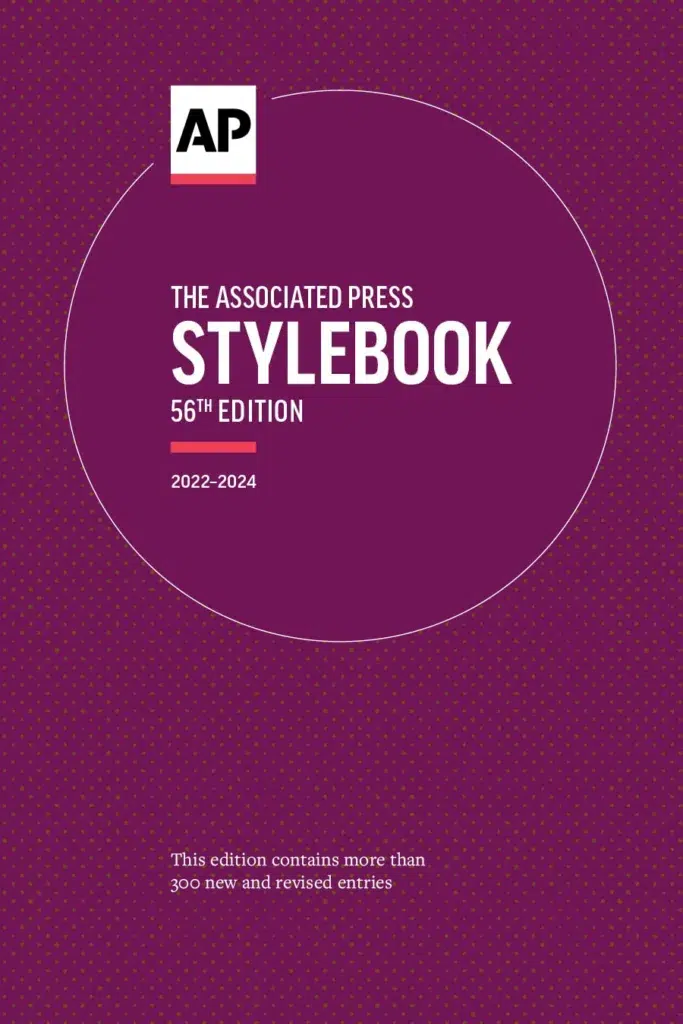In this blog item, JGPR Academy is offering an Associated Press Style cheat sheet tailored for Public Information Officers (PIOs) seeking to improve their ability to produce content and news releases in Associated Press Style (AP Style). We tried to highlight key items and frequently mistaken terms that are most relevant to a PIO’s work in communicating with the public and the media.
The AP Stylebook is a staple in newsrooms and PR shops across the country. Buy your copy of the AP Stylebook today on Amazon! JGPR Academy also offers a self-directed press release writing class that includes more AP Style hints and tips!
General Principles
- Consistency: Use the same style and terms throughout your communication to avoid confusion.
- Clarity: Aim for clear and straightforward language, avoiding jargon and technical terms when possible.
- Conciseness: Be brief but comprehensive. Deliver your message in as few words as necessary.
Punctuation
- Commas: Use commas to separate elements in a series, but do not place a comma before the conjunction in a simple series (e.g., The flag is red, white and blue). We disagree with this in principle…I prefer to use the Oxford of serial comma before the conjunction, but this is strictly an AP Style guide…
- Periods: Use single spaces after periods.
Dates, Times, and Numbers
- Dates: Abbreviate months with six or more letters if they are used with a specific date (e.g., Jan. 2, Oct. 19). Spell out months when used alone or with a year only.
- Times: Use figures except for noon and midnight. Use a colon to separate hours from minutes (e.g., 3 p.m., 11:00 a.m.).
- Numbers: Spell out numbers one through nine. Use figures for 10 and above.
Capitalization
- Titles: Capitalize formal titles when they appear before a name. Lowercase titles if they are informal, appear without a name, follow a name, or are set off by commas.
- Organizations: Capitalize the full names of organizations and institutions.
Abbreviations and Acronyms
- First Reference: On first reference, spell out the full name of an organization or program followed by the acronym in parentheses if it is to be used again (e.g., Federal Emergency Management Agency).
- Subsequent References: Use the acronym only. (FEMA)
Geographic Locations
- Cities: On first reference, use the city’s full name. The state name should follow it, abbreviated according to AP style (e.g., Dallas, Texas).
- States: Spell out state names when they appear alone and use AP abbreviations when paired with a city (not USPS two-letter codes). AP Style uses Mass. for Massachusetts, not MA. Conn. for Connecticut not CT. Certain states are never abbreviated, including Maine, Texas, Iowa, Utah and Idaho.
Miscellaneous
- Technology Terms: Use common technology terms appropriately and ensure their spelling is correct (e.g., email, internet, website).
- Social Media References: When citing social media, use the individual’s or organization’s exact username or handle.
- Referencing Posts: When referencing social media posts, include the date of the post and the platform it was posted on. If quoting directly, ensure the quote is exact and attribute it to the correct individual or entity.
- Hashtags and Handles: Use hashtags and handles as they appear on social media, but explain or contextualize them if their meaning isn’t immediately clear to your audience.
Language and Tone
- Objective Language: Use neutral language and avoid bias.
- Active Voice: Prefer the active voice over the passive for clarity and brevity.

